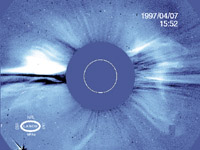|
Hurricane Sol One of the most important solar events from Earth's perspective is the coronal mass ejection (CME), the solar equivalent of a hurricane. A CME is the eruption of a huge bubble of plasma from the Sun's outer atmosphere, or corona. The corona is the gaseous region above the surface that extends millions of miles into space. Thin and faint compared to the Sun' surface, the corona is only visible to the naked eye during a total solar eclipse. Temperatures in this region exceed one million degrees Celsius, 200 times hotter than the surface of the Sun.
How the corona can be so much hotter than the surface remains a
mystery to scientists, but most suspect that it has to do with
the complicated magnetic fields that burst from the interior and
extend above the surface in great arches and loops. The buildup
and interaction of these magnetic loops-which can stretch over,
under, and around each other-seems to supply the energy to heat
the corona and produce the violent explosion of a CME.
According to some of the newest observations and theories, the
larger and higher magnetic loops of the Sun's field are believed
to hold down the newer, smaller fields emerging from the surface.
They also tie down the hot plasma carried by those fields. Much
like a net holding down a helium balloon, this network of magnetic
loops restrains the plasma and magnetic fields trying to rise into
the corona. This causes tremendous energy to build. Eventually,
some of the overlying magnetic loops merge and cancel each other,
cutting a hole in the magnetic net and allowing the CME to escape
at high speed.
Researchers compare this process to that of filling helium balloons.
If you inflate a balloon without holding it down, it will slowly
drift upward. But if you hold the balloon down with a net, you
can generate a lot of force when you fill it, causing it to push
upward. Once you remove the net, the balloon shoots skyward.
Just hours after blowing into space, a CME cloud can grow to
dimensions exceeding those of the Sun itself, often as wide as 30
million miles across. As it ploughs into the solar wind, a CME can
create a shock wave that accelerates particles to dangerously high
energies and speeds. Behind that shock wave, the CME cloud flies
through the solar system bombarding planets, asteroids, and other
objects with radiation and plasma. If a CME erupts on the side of
the Sun facing Earth, and if our orbit intersects the path of that
cloud, the results can be spectacular and sometimes hazardous.
|
Brought to you by the International Solar-Terrestrial Physics Program and NASA.


